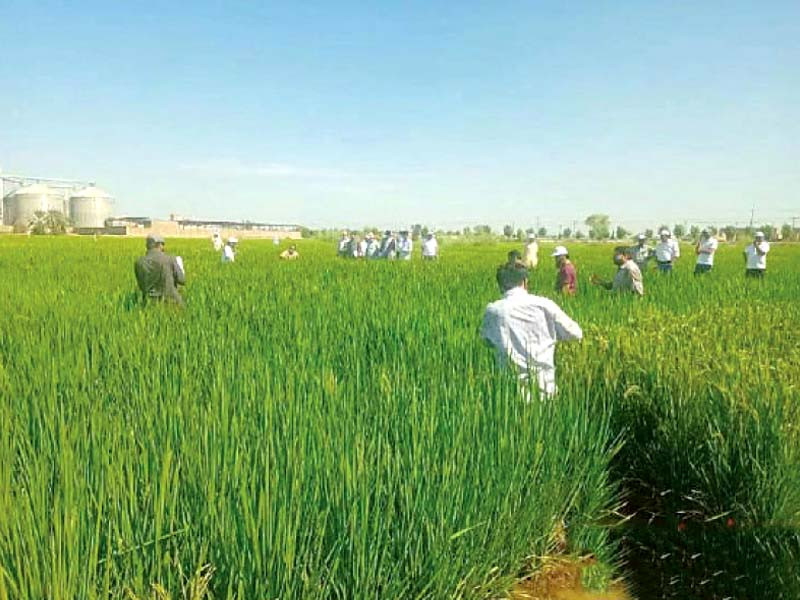
Pakistan is a huge rice-growing country and its paddy area reached 3.3 million hectares in the year 2021. However, problems such as drought and salinity have made large arable land vacant, which has greatly affected its total rice production.
“In Pakistan, only 22-23% of land is cultivated,” said Karachi Chamber of Commerce and Industry Vice President Shamsul Islam Khan. “There is vast uncultivated land because of water depletion.”
In recent years, China has cultivated drought-resistant and salt-resistant rice varieties. To know more about it, the China Economic Net interviewed Xu Jianlong, Chief Scientist of Rice Molecular Design Technology at the Institute of Crop Sciences in the Chinese Academy of Agricultural Sciences.
“There is a popular saying that farming accounts for roughly 70% of human water consumption and water used in rice fields accounts for 70% of the entire agricultural water consumption,” said Xu.
“Drought-resistant varieties in China can save about 30% of water. Under drought conditions, drought-resistant varieties can also grow normally and yield losses can be avoided.”
Pakistan is also a country affected by land salinity. “About 30% of Pakistan’s planting areas are affected by salinity. Just as drought-resistant varieties are required due to shortage of water resources, salt-resistant varieties are also needed to make full use of saline land.”
Xu noted that several salt-resistant varieties have been approved and promoted in China and got good production.
“In Tianjin, China, there is a rice variety called Xiaozhan rice, which is very delicious.”
Xu said that rice grown in saline soil tastes better than the same variety grown in ordinary soil. “It is salt tolerant and planted in a slightly saline environment, and its irrigation water also contains a certain amount of salt. The minerals contained in salt contribute to the slow but sufficient accumulation of starch in rice, so the taste is better.”
“To solve the current problems of rice production in Pakistan, new varieties can be introduced from China for trial planting. Pakistan can also introduce China’s advanced agricultural machinery and planting technology suitable for small farmers to help them increase rice production,” Xu suggested.
Seed cooperation
“We look forward to establishing a technology transfer-product process-export model for seed cooperation with Pakistani partners,” said Zhou Xusheng from Wuhan Qingfa Hesheng Seed Company Limited in an exclusive interview with China Economic Net.
“Under this model, we grow crops in Pakistan utilising Chinese technology together with local companies and then sell the processed products back to China.”
Take hybrid rice as an example. Pakistan, once the world’s seventh-largest rice exporter, became the fourth-largest after the introduction of hybrid rice from China, which improves production by 50-80% and enhances the processing quality by 10%.
By doing so, local farmers benefit from rice of higher quality and more production, local enterprises become more competitive in the global market and huge revenue can be brought.
The seed company, with nearly two decades of experience in promoting hybrid rice in Pakistan, has contributed to the examination of the first Chinese hybrid rice variety QY0413 in Pakistan’s history and developed Komal, the first hybrid rice variety with long growth period in Pakistan.
Currently, the company is providing seeds of hybrid rice, rapeseed, tomato, pepper, and watermelon in Pakistan.
Research is also underway in Sindh for heat and alkaline-resistant rice varieties but to set up a complete technology transfer-product process-export chain, more needs to be done.
According to Zhou, to build the model well, first there should be high-quality selected varieties that can be adapted to local conditions in Pakistan.
According to Trade Development Authority of Pakistan (TDAP), the average rice yield of Pakistan is generally lower than that of China, the US, North Korea, South Korea, India, Bangladesh, Vietnam, the Philippines, Brazil, Egypt and Iran.
In the past 10 years, the average rice yield in Pakistan almost stagnated with only a slight increase. To solve this problem, Pakistan can only rely on introducing high-yielding varieties.
In this regard, Zhou recommended more research and development and investment in varieties with good quality, high production, and resilience to local climate.
According to Zhou, a complete rice grading mechanism that distinguishes rice of different qualities for different purposes, as well as enhanced awareness of the value of high-quality rice throughout the planting, purchasing, processing, and exporting process are also needed.
THE ARTICLE ORIGINALLY APPEARED ON THE CHINA ECONOMIC NET
Published in The Express Tribune, April 15th, 2022.
Like Business on Facebook, follow @TribuneBiz on Twitter to stay informed and join in the conversation.


















COMMENTS
Comments are moderated and generally will be posted if they are on-topic and not abusive.
For more information, please see our Comments FAQ